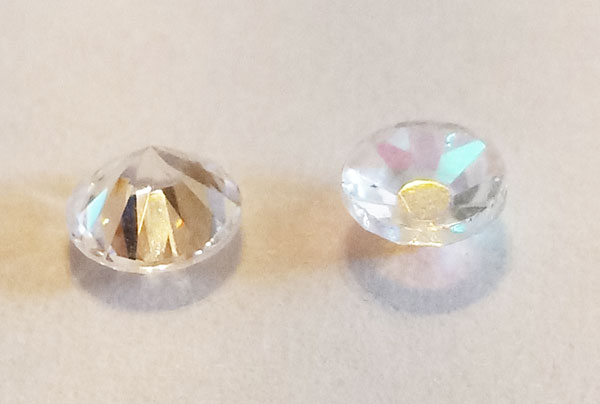|
Sometimes people use certain words interchangeably when the words mean two separate things. And if you’re not familiar with the terms, you can get confused pretty easily. For example, when buying rhinestones, is there a difference between flat back and glue on rhinestones? The Chaton, the World’s First Cut Crystal Rhinestone In the world of bling, several types of rhinestones can have a flat back: sew-on, hot-fix, and glue on. All these embellishments have a backside that is smooth without peaks or depressions. However, manufacturers only term glue on rhinestones as flat back or non-hot fix. Before we talk about the differences in these rhinestones, let’s look at a bit of crystal history. Originally, glassmakers created rhinestones to replicate gemstones, particularly diamonds. When found in nature, one of the most common shapes of a diamond is an octahedron. This is an 8-sided figure that looks like 2 pyramids connected at the base. Early gem cutters didn’t have the technology to cut multiple facets as they do today. Instead, jewelers would smooth these natural facets to enhance the reflection of light. The chaton, the world’s first patented cut crystal stone, copied this shape. At this time, artisans mainly used rhinestones for jewelry making. However, the fashion industry would soon begin using these sparkling crystals. Chiefly, the World Exhibition in France in 1878 created a new demand for “diamond jewels” for clothing. Thus, manufacturers began to create the flat back rhinestone. Sew-On, Hot Fix, and Glue On Rhinestones Today, manufacturers still create the pointed back chaton. These can be either foiled like flat backs or unfoiled like diamonds. As mentioned earlier, you’ll also find sew-on, hot fix, and flat back rhinestones. While all have a smooth back, the attachment methods differ. Generally, sew-on rhinestones have holes to sew the embellishment into place. Most have two very small holes located near the edge. One, the Lochrosen, is sort of like a crystal sequin with a hole in the middle of the crystal. Another option is the hot fix rhinestones with a heat-activated adhesive on the flat side. If you properly apply it, the glue forms an extremely strong bond that you can wash. To apply, you need a heat press, hot fix applicator, or non-steam iron heated to 250 - 340 degrees F. Often, you may see glue on rhinestones referred to as “non-hot fix” or simply flat backs. While gluing is the preferred method of attaching this type of rhinestone, it’s not the only technique. You can also attach these embellishments by using either rim or Tiffany metal settings. Which Is The Best Type of Rhinestone For Your Bling Project? Usually, the type of bedazzling project and the material you’re using will help you choose the best rhinestone. For example, western wear garments typically use leather, a tricky material for gluing rhinestones. Using metal settings in this instance will result in a very secure hold. Some shoes and handbags may also require metal settings. Generally, flat back rhinestones are more popular among the DIYers. In addition to a cheaper price, not all materials, like tightly woven fabrics, are suitable for hot fix applications. Moreover, the gluing method is a bit easier for first-timers. Plus, you usually have more of a selection of colors, sizes, and shapes with flat backs. If you’re looking for a large selection of colors and sizes in flat back rhinestones, trust Rhinestones Etc. Since 2011, we’ve been supplying quality embellishments with fast shipping, competitive pricing, and excellent customer service. Browse our online store to find the perfect hue for your bling project!
0 Comments
Your comment will be posted after it is approved.
Leave a Reply. |
KarenI have been adding bling for over 20 years. Through my projects, I hope you find inspiration. Categories
All
Archives
July 2024
|
Home About Policies Return Shipping
Contact Us Size Chart Privacy Products Reviews
Copyright 2024 Rhinestones Etc. All rights reserved.
Contact Us Size Chart Privacy Products Reviews
Copyright 2024 Rhinestones Etc. All rights reserved.


 RSS Feed
RSS Feed